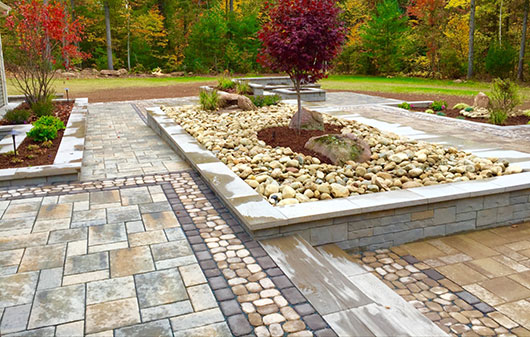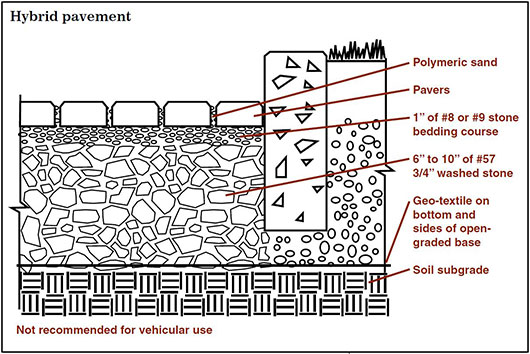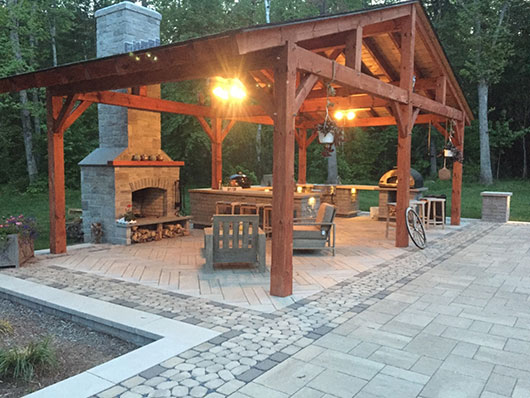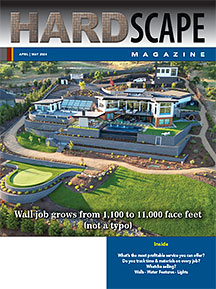Construction articles

A section of the 2015 hybrid pavement experimental test site.
Hybrid – pavers & poly sand over drainage stone – without fabric
By Phil BahlerHow many of us in the hardscape industry are amazed at how many changes there have been regarding installation practices? We live in a fast-changing world where some products can become obsolete before they are put into production. Over the past 33+ years I have seen some amazing changes.
To help you understand my thought process for this article, let me share a little bit of my history and background. In 1985 my 3 brothers and I started Bahler Brothers. One of our first jobs was installing a Uni-Décor patio (an octagon with an attached square). Do you remember those?
As our business grew, we gravitated towards hardscaping and would plow in the winter to help with cash flow. We eventually realized we only made money about every third year with snow plowing, so we soon gave it up.
Instead, we would spend our winters cutting and torching our own unique tools to help us be more successful installing pavers and retaining walls. In 2006 we established Pave Tool (PaveTool.com) so we could offer our tools to other contractors. To date, we’ve created 36+ tools with 5 or 6 more to debut this fall.
I have always worked in the field and have never had an “office position” in my own company. I’m constantly observing and searching out better, quicker and easier ways to install. One of these ways being what I like to call, hybrid pavement, a combination of a regular interlocking paver installation and permeable paver installation.
Basically, the hybrid pavement uses permeable paver installation methods and drainage stone for the base and setting bed, and combines them with standard pavers and polymeric sand joints. The hybrid pavement is structured in such a way that
- we don’t have the freeze/thaw expansion issues that you get using a dense graded base,
- we have built-in drainage,
- we can get a nice polymeric sand finish to our pavement, and
- there’s minimal efflorescence.
Last check, this installation practice was not yet approved by ICPI. But, I believe you're going to see it become widely accepted because it's so effective.
A problem with fines
What brought me to this hybrid pavement concept? Problems with past installation methods.As I reflect back to 1985, the accepted wisdom was to install hardscapes on 8” to 12” of stone dust, the stuff that’s left over when quarries process stone. There are vast differences in stone dust from different quarries across the country.
Our local stone dust has so many fines that it would harden up almost like concrete. Not good for a setting bed. It would become so hard that pavers would shift laterally, especially under vehicular traffic. We had to replace a lot of driveways because of stone dust.
Sometime after stone dust, ASTM D2940 gravel became the recommended base material. Unlike stone dust, D2940 gravel is at least consistent, 3/4” dense grade gravel down to fines. But it still shares some of the same problems as stone dust.
The fines allow D2940 gravel to hold moisture causing the mass of base material to expand during freeze/thaw cycles. When used as backfill in a raised patio/front stoop, I've seen stairs spread apart year by year to the point where it's not even safe.

#57 rocks
I’m a big fan of ASTM #57 3/4” clean washed stone, the base for the hybrid pavement. But, we started using it to backfill our raised patios nearly 25 years ago, long before the hybrid pavement. Since #57 stone has no fines, it solved the freeze/thaw expansion issue we had with D2940 gravel.We realized a tremendous savings by switching to #57 stone. A truckload costs slightly more than D2940 gravel, but it requires far less compaction time, and there’s far less waste.
- Less compaction time
A dense grade product like D2940 gravel takes a tremendous amount of compaction to get it up to 98% proctor density. In contrast, #57 stone is compacted to 95% just being dumped out of the truck. Hit it with a small plate compactor (minimum 4,500 lbs centrifugal force) in an 8” or 12” lift and you achieve that full compaction rating in no time. - Less product waste
Since #57 stone arrives 95% compacted you only lose up to 5% of it during compaction. When using D2940 gravel you will lose 25% to 30% when you compact it to the required 98% proctor density.
It takes a lot of effort and a powerful compactor to achieve 98% proctor density with D2940 gravel. I believe this is a major reason jobs aren’t properly compacted, and it’s a major reason for failures. Probably the most important advantage of #57 stone is that it almost ensures sufficient compaction gets done.
A few complications
When you use #57 stone as a base material you run into the same edge restraint and drainage management issues as you do with a permeable paver installation.Edge restraints – You need to follow permeable paver installation practices for restraining your edges. Standard edge restraint spikes won’t hold when pounded into an open-graded base.
Near house foundations – Since your drainage stone base is a reservoir for water, you will want to keep that water away from foundations, especially if there is living space on the other side of the concrete. Consider using a densely graded material up against the foundation. Slope the sub-base at 3/8” per foot away from the house for at least 10’ minimum. In extreme cases you can use a rubber membrane.
The problem of fabrics & efflorescence
Before we began experimenting with our hybrid pavement, we used these 2 methods to build raised patios:1. One, we would install a geo-textile fabric, our #57 stone, another layer of fabric, then 2” of D2940 gravel, 1” of C33 sand and then pavers.
2. Our second method consisted of a layer of fabric, #57 stone, another layer of fabric, 1” C33 sand, and then our pavers.
Both methods produced great end results with 1 exception: Even though we used a well-draining fabric below the sand setting bed, we found it still tended to hold excess moisture that caused efflorescence, a white powdery substance that occurs on the surface of pavers as moisture wicks its way out of the concrete.
How to reduce efflorescence?
For years we puzzled how we might change our installation methods to reduce efflorescence. Then, an idea occurred to us. We could use #9 (3/8” clean washed) stone for the setting bed like we do in permeable paver installations with no fabric anywhere near the pavers.With the #9 stone installed directly on top of the #57 stone, no fabric and no fines, any water quickly drains right through that base and it's gone.
The twist was that we also wanted to use standard (not permeable) pavers along with polymeric sand. So, we tried it. In the fall of 2015 Pave Tool Innovators, Bahler Brothers and Techo-Bloc collaborated on an experimental test site.
We installed a 4,000 sf patio with SRW seat walls, fire pits and an outdoor kitchen. All were built on a raised patio hybrid pavement structure.
- We installed soil stabilization fabric, 8” of #57 drainage stone, 1” of #9 drainage stone and pavers. Polymeric sand was installed in most of the pavers. In some areas, the #9 stone was installed in the gaps to serve as drains to the #57 drainage stone below. Rather than using permeable pavers, we used standard pavers that had larger gaps to make room for the #9 stone.

Another section of the 2015 hybrid pavement experimental test site.
The results are in
In conclusion, I would have to say I am extremely happy with the results. No efflorescence issues. On this 4,000 sf patio, there was a 9” long joint where the sand failed, and I believe that was because not enough sand was swept in. We haven’t had any additional sand loss over the 3 years since the install, and sand loss hasn’t come up as an issue on other hybrid pavement projects.Pros and cons of hybrid pavement
- Pros
1. #57 stone is 95% compacted when dumped out of your truck, this saves a tremendous amount of time compacting.
2. When using D2940 gravel base you will lose 25% to 30% of mass due to compaction. This equals a tremendous amount of dollar savings on trucking when you use #57 stone.
3. When using hybrid pavement, moisture dissipates quickly due to the open void space in the stone base. We rarely find any issues with efflorescence due to that fact.
4. If you wet cut in place, hybrid pavement is a great solution. Water from cutting dissipates quickly, and your slurry from cutting is easily washed off into the open grade base. If you have ever cut wet using C33 sand on a dense grade you know your sand washes away easily.
5. #57 stone is unaffected by frost therefore you will see less movement in your paved surface due to freeze/thaw cycles.
6. If you have the unfortunate experience of working in the rain, you will find the #57 stone doesn’t get mushy or difficult to work with.
7. You can eliminate unattractive surface drains, by leaving any area permeable to collect runoff water, which will permeate down through your base. - Cons
1. Edge restraint is more costly and time consuming to install.
2. You use about 5% more polymeric sand since the sand has to choke out (fill) some void space in the #9 stone.
3. Any time you do something new, you always have a learning curve although this is not a difficult transition, it doesn’t last long, and you’ll be better off once you get it down.
Today we use the hybrid pavement on a lot more than raised patios. Other contractors out there are doing all their base using the hybrid pavement method. We’re seeing extremely good end results with it.
Phil Bahler is the owner of Pave Tool Innovators founded in 2006. He is still involved with Bahler Brothers hardscape contractors where he was a co-owner for 33 years. Contact Phil at PB@PaveTool.com or visit PaveTool.com













